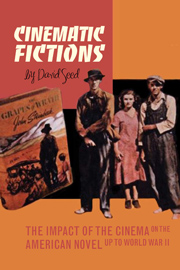Book contents
- Frontmatter
- Contents
- Introduction
- 1 Beginnings
- 2 Modernist Experiments: Gertrude Stein and Others
- 3 H.D. and the Limits of Vision
- 4 Ernest Hemingway: The Observer's Visual Field
- 5 Success and Stardom in F. Scott Fitzgerald
- 6 William Faulkner: Perspective Experiments
- 7 John Dos Passos and the Art of Montage
- 8 Dreiser, Eisenstein and Upton Sinclair
- 9 Documentary of the 1930s
- 10 John Steinbeck: Extensions of Documentary
- 11 Taking Possession of the Images: African American Writers and the Cinema
- 12 Into the Night Life: Henry Miller and Anaïs Nin
- 13 Nathanael West and the Hollywood Novel
- Bibliography
- Index
9 - Documentary of the 1930s
- Frontmatter
- Contents
- Introduction
- 1 Beginnings
- 2 Modernist Experiments: Gertrude Stein and Others
- 3 H.D. and the Limits of Vision
- 4 Ernest Hemingway: The Observer's Visual Field
- 5 Success and Stardom in F. Scott Fitzgerald
- 6 William Faulkner: Perspective Experiments
- 7 John Dos Passos and the Art of Montage
- 8 Dreiser, Eisenstein and Upton Sinclair
- 9 Documentary of the 1930s
- 10 John Steinbeck: Extensions of Documentary
- 11 Taking Possession of the Images: African American Writers and the Cinema
- 12 Into the Night Life: Henry Miller and Anaïs Nin
- 13 Nathanael West and the Hollywood Novel
- Bibliography
- Index
Summary
In the cases of Dreiser and Sinclair we saw examples of fiction embedding their action in reports on social conditions, in other words of fiction approaching documentary. It has been an abiding dream of the cinema that it could depict reality directly. A 1902 advertisement for the kinetoscope claimed that it could give ‘apparently life itself’ in its directness and breadth. Documentaries, it seemed, had finally achieved this ultimate objectivity. The term ‘documentary’ was first applied in 1926 to Moana, a film about a Polynesian family, and by 1930 had taken on its current sense of a generic marker. The fact that it was applied to an ethnographic film has an important symbolism because, as Eliot Weinberger has shown, it reflects ethnographers' belief that they are invisible and can therefore produce their report without disrupting the communities under observation. Their ideal is ‘either a dream of invisibility, or worse, the practice of the surveillance camera’. If we broaden this category of film to include social reportage, we can see that Weinberger is raising an issue which will recur throughout this chapter. Whether the subjects of film are Polynesians or American migrant workers, for the investigative writer or film-maker the problem remains of how to report on their lives without disrupting their living habits and also without presenting them as alien to the viewer/reader.
- Type
- Chapter
- Information
- Cinematic FictionsThe Impact of the Cinema on the American Novel up to World War II, pp. 173 - 193Publisher: Liverpool University PressPrint publication year: 2009



